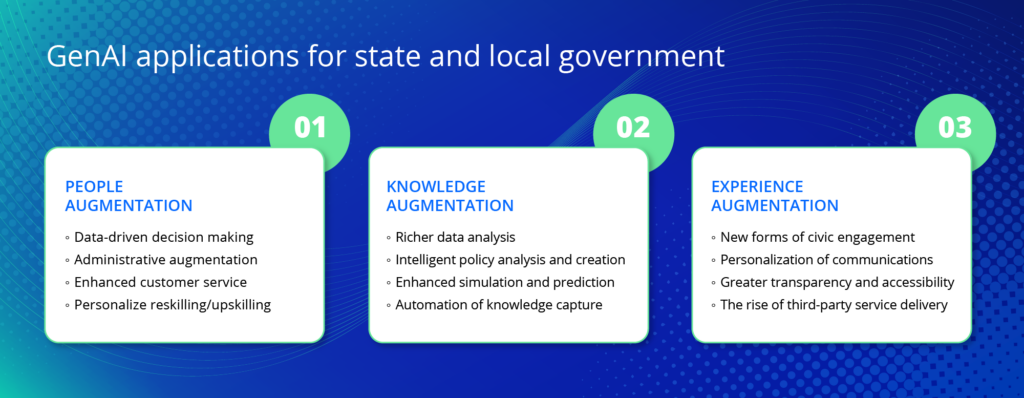Artificial intelligence (AI) is changing the game for public sector organizations and agencies—it has the potential to revolutionize the way governments address society’s needs and challenges, such as improving public safety, quality of life and workers’ productivity.
Many governments worldwide are actively responding to the rapid advancement in AI technologies, specifically generative AI (GenAI). In fact, 25% of governments have deployed or plan to deploy GenAI in the next 12 months, according to the 2024 Gartner CIO and Technology Executive Survey. An additional 25% plan to deploy it in the next 24 months. The Boston Consulting Group estimates the productivity gains of GenAI for the public sector will be valued at $1.75 trillion per year by 2033.

However, the Gartner survey also predicted that less than 25% of government organizations will have GenAI-enabled citizen-facing services by 2027 due to fear of public failure and a lack of community trust in government use of the technology. This number isn’t surprising as the adoption of GenAI (and AI in general) in state and local government has been slower compared to that in the private sector, which can be attributed to various challenges in adoption and usage.
Understand key GenAI challenges
Global government response to AI
- In the U.S.:
- All U.S. federal agencies are now required to have a chief AI officer responsible for overseeing all AI systems for the respective agency. This guidance expands on the AI executive order issued by U.S. President Biden in October 2023, which required federal offices to create safety standards and increase the number of AI talent working in government.
- In the EU:
- In March 2024, The European Parliament adopted the Artificial Intelligence Act, which is considered to be the world’s first comprehensive horizontal legal framework for AI. It provides for EU-wide rules on data quality, transparency, human oversight and accountability.
Note: Globally, “regulation is incomplete and highly likely failing to anticipate future developments,” according to the U.K. government.
In addition to increasing policies, state and local governments that are already using GenAI, or looking to adopt it, need to be aware of—and prepared to navigate—the most imminent challenges to ensure their GenAI is or will effectively improve operations and citizen service delivery.
According to the Center for Public AI, these are four key challenges:
No. 1: Following government procurement rules. AI and/or AI model usage must be disclosed in procurements. Governments must be indemnified from liabilities with copyright, IP (intellectual property), etc. associated with AI usage.
No. 2: Preparing for ‘Bring Your Own AI’. There is a growing trend of employees using their personal AI at work for productivity benefits. This creates major security implications for public sector organizations. According to a new Microsoft report, 75% of employees globally are using AI at work, with 78% of them using it outside of official company strategy and rules.
No. 3: Updating organization’s privacy policies. State and local governments must update their data and privacy rules and regulations to account for their policies on AI usage, training, etc.
No. 4: Reskilling and upskilling employees to ensure AI literacy and equity. Governments will need to develop professional development and training programs for their workforce to help them understand how GenAI affects their day-to-day duties, the benefits of using it, and how to learn and adapt to new ways of working. Governments can look to private sector partners already doing this for learnings and inspiration.

Trailblazing GenAI Innovation
Dataminr’s Founder and CEO gives a lightning talk on ReGenAI and the evolution of Dataminr’s AI Platform at the MIT and Forbes’ Imagination in Action AI Conference.
WATCH NOWAdopting GenAI: Recommendations for state and local governments
As you look to deploy GenAI or improve your current implementation, consider the following best practices. They will not only help you extract greater value from your chosen GenAI solution, but also ensure that its use in the public service remains safe.
- Set the guardrails. Establish comprehensive frameworks, including acceptable employee use and general use of AI, to provide the initial guardrails and transparency on GenAI utilization.
- Build internal governance. Create a task force composed of representatives from different departments to share GenAI use cases and provide feedback. Tip: Align your areas of experimentation to key organizational objectives at the outset to avoid having to connect a technology to an underlying problem after the fact.
- Experiment and empower. Create a culture of experimentation through training, empowerment, licensing, etc. It’s difficult to create game-changing GenAI use cases from the top—you need to have a strategy to empower, equip and learn from all employees, not just the executives.
- Connect the dots. It’s possible that you’ll find gaps within your existing data as you experiment with GenAI. Find ways to connect those data silos, as all AI—including GenAI—requires the right data foundation to provide actionable intelligence. Also, recognize that this step may require significant work and semantic linkage over time.
- Operate in a state of continuous improvement or beta. Successful public sector AI utilization requires being adaptive and agile with your existing AI approaches. Tip: have your AI task force meet frequently to facilitate continuous feedback and collaboration.
- Partner strategically and carefully. There are numerous potential AI applications and services available to the public sector. Ensure you approach each with the same level of scrutiny over details (e.g. training, bias, records retention, etc.), even when piloting the tech.
AI technologies will continue to evolve fast beyond GenAI with new breakthroughs expected in the near future. It’s critical that state and local governments understand the tech’s potential, limitations and risks, and adoption challenges and best practices—while staying abreast of local, national and global regulations and guidelines—to ensure that the services they provide to the public are secure, efficient and effective.
Dataminr’s Regenerative AI
Learn about Dataminr’s regenerative AI—a new form of generative AI that automatically regenerates textual descriptions as events unfold—and how it enables governments to rapidly understand the scope and impacts of critical events, enabling them to act faster and keep their people and assets safe in an increasingly unpredictable world.
Learn More



